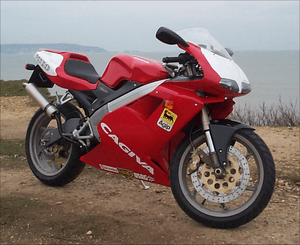Cagiva
 Power to the People | |
| Subsidiary | |
| Industry | Motorcycle manufacturing |
| Predecessor | Aermacchi Harley-Davidson |
| Founded | 1978 |
| Founder | Giovanni Castiglioni |
| Headquarters | Varese, Italy |
| Products | Motorcycle |
| Parent | MV Agusta Motor S.p.A. |
| Website | www.cagiva.it |
Cagiva is an Italian motorcycle manufacturer. It was founded in 1950 by Giovanni Castiglioni in Varese, originally producing small metal components. Giovanni's sons, Claudio and Gianfranco Castiglioni went into the motorcycle industry in 1978. The name is a portmanteau derived from the founder's name 'Giovanni Castiglioni' and the founding location, i.e. CAstiglioni GIovanni VArese.
In its history, Cagiva won races in Dakar and Motocross competitions, as well as in Grand Prix motorcycle racing.
History

In 1978 Cagiva entered the motorcycle business with two racing motorcycles ridden by Gianfranco Bonera and Marco Lucchinelli. In the same year it bought a factory in Schiranna, Varese from Aermacchi/AMF-Harley-Davidson and went into motorcycle production. By 1979 the company reached an annual production of 40,000 motorbikes, with eight models powered by two-stroke engines ranging from 125 cc to 350 cc.
Many of the Harley-Davidson models were continued in production as Cagivas, and the off-road motorcycle division was improved and expanded, eventually producing its own race-winning WMX series of moto-cross motorcycles.
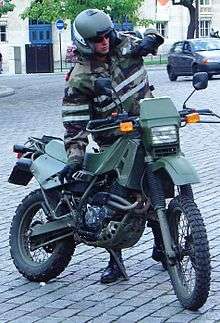
In 1983 Cagiva also sourced Ducati four stroke v-twin engines from 350 cc to 1000 cc and entered the big displacement market. Cagiva bought Ducati in 1985, but kept the Ducati brand that was better recognized outside Italy. Ducati motorcycle production continued in Bologna, while the Varese-built Cagiva Ala Azzurra (sold under the name "Alazzurra", "Bluewing") and Elefant were introduced, both featuring Ducati engines.[2]
Cagiva continued with strategic buyouts of Moto Morini in 1985 and Husqvarna in 1987. In 1991 Cagiva also bought the trademarks for the MV Agusta brand.
In 1996, Cagiva accepted the offer by the Texas Pacific Group and sold the Ducati and Moto Morini brands. In 1999, for strategic purposes, the company was restructured. MV Agusta Motor become the main brand comprising Cagiva and Husqvarna.[3]
In 2000, production of the Cagiva roadster ended. In 2008, Harley-Davidson bought MV Agusta Motor, the parent company of Cagiva, thereby regaining some control of its old Aermacchi factory.
In October 2009, Harley-Davidson informed that it would put Cagiva up for sale. In the August of the following year, Cagiva was bought back by the son of the founder and former owner Claudio Castiglioni.
In 2012, production of new high engine capacity Mitos ended. Increasingly stringent environmental emission requirements and the concentration of resources on MV Agusta's F3 were cited as reasons. The last few Mito SP525s produced were white in colour, and personally signed by MV Agusta CEO Giovanni Castiglioni, thus ended the legacy of the Mito, alongside the end of the Raptors.
Cagiva currently produces Raptor 125cc and Mito 50cc and 125cc.
Racing
In the early 1980s Cagiva began to manufacture dirt bikes and started a massive public relations program with the opening of its North American branch. It hired Ron Turner and Duane Summers to test and develop its bikes. Cagiva motocross bikes were characterized by their fast powerful engines and innovative features, such as the MX line that had only one spring in the front forks with one fork controlling dampening and the other spring.
500cc World Championship
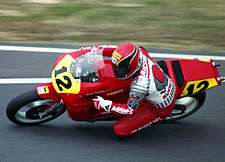
At the end of the 1970s the company began campaigning the Grand Prix motorcycle racing circuit. Randy Mamola was its lead rider from 1988 to 1990, and he achieved Cagiva’s first podium result. It would also have some technical assistance from Yamaha. In 1991 it signed former world champion Eddie Lawson to its team. Lawson would claim the company's first victory when he won the 1992 Hungarian Grand Prix. John Kocinski would also win a Grand Prix on a Cagiva GP500 (C594), finishing third in the 1994 world championship.
Dakar Rally
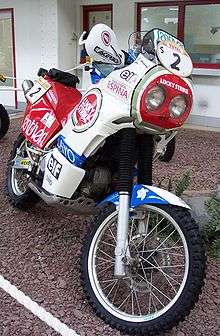
In 1990 and 1994 the Italian rider Edi Orioli won the Dakar Rally on the Ducati-powered Cagiva Elefant.
| Year | Champion | Motorcycle |
|---|---|---|
| 1990 | |
Cagiva Elefant |
| 1994 | |
Cagiva Elefant |
Motocross World Championship
- 125 cc class
| Year | Champion | Motorcycle |
|---|---|---|
| 1985 | |
Cagiva WMX |
| 1986 | |
Cagiva WMX |
Motocross World World Constructors champions
- 125 cc class
- 1985, 1986, 1987
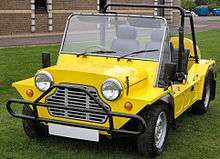
Mini Moke
Cagiva bought BMCs design for the Mini Moke, manufacturing them in Portugal using British built engines from 1990 until 1993. Intending to transfer production to the Bologna factory early in 1995, the tooling for the Moke was transferred to Italy late in 1993, but production never restarted.
Past models


Road
- Alazzurra 350, Ducati engine
- Alazzurra 350 GT, Ducati engine
- Alazzurra 400, Ducati engine
- Alazzurra 400 GT, Ducati engine
- Alazzurra 650, Ducati engine
- Alazzurra 650 GT, Ducati engine
- Aletta Oro 125 S1
- Aletta Oro 125 S2
- Blues 125
- Freccia C9 125
- Freccia C10 125
- Freccia C12 125
- Mito
- Mito Mk II
- Mito Ev
- Mito SP525
- SS 175
- SST 125
- SST 250
- SST 350
- SuperCity 50/75
- SuperCity 125
- Roadster 521
- Roadster 200
- Low Rider 125
- Prima 50/75
- Planet 125
- River 500
- River 600
- Raptor 125
- Raptor 650, Suzuki engine
- V-Raptor 650, Suzuki engine
- Raptor 1000, Suzuki engine
- V-Raptor 1000, Suzuki engine
- Xtra Raptor 1000, Suzuki engine
Off road
- WMX 125
- WMX 200
- WMX 220
- WMX 250
- WMX 500
- MXR 250
- RX 250
- MXR 500
Adventure - dual sport


- SXT 125
- SXT 175
- SXT 200
- SXT 250
- SXT 350
- T4 350 E
- T4 350 R
- T4 500 E
- T4 500 R
- Ala Blu 125
- Ala Blu 250
- Ala Blu 350
- AR Aletta Rossa 125
- AR Aletta Rossa 200
- AR Ala Rossa 350
- Elefant 125
- Elefant 350, Ducati engine
- Elefant 650, Ducati engine
- Elefant 750, Ducati engine
- Elefant 900, Ducati engine
- Canyon 500
- Canyon 600
- Gran Canyon 900, Ducati engine
- W4 50/75/80
- W8 125
- W12 350
- W16 600
- Cruiser 125
- Tamanaco 125
- N90 125
- Cocis 50
- Navigator 1000, Suzuki engine
Scooter
- Passing 125 (Scooter)

See also
References
- ↑
- ↑ 1985-1987 Cagiva Alazzurra Motorcycle Classics article, Jan/Feb 2008
- ↑ "Cagiva Recent Facts". Cagiva. Retrieved 2008-02-03.
External links
| Wikimedia Commons has media related to Cagiva motorcycles. |

